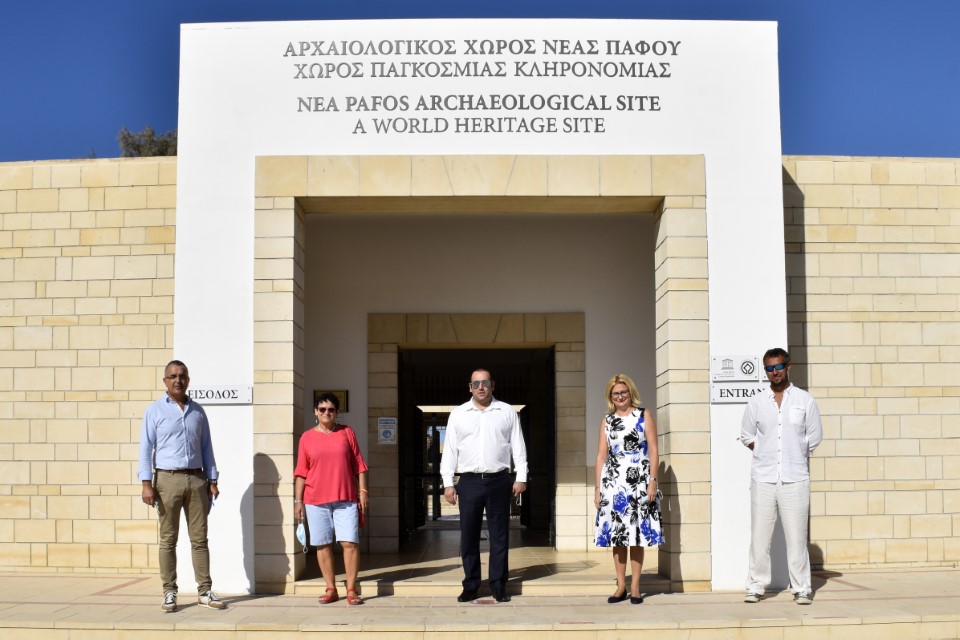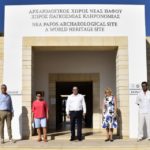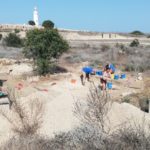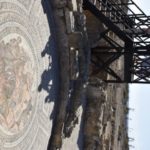On October 15, in Nea Paphos, the 55th anniversary of Polish archaeological research at the site was celebrated with an official function. It was attended by representatives of the Cypriot authorities, the Embassy of the Republic of Poland in Cyprus, as well as a team of Polish archaeologists who have been working in Nea Paphos as part of a new, joint expedition since the beginning of October.
Nea Paphos is one of the most important sites of Greek-Roman Cyprus, and for several centuries it was the capital of the island. It has been included in the UNESCO World Heritage List since 1980. Polish archaeologists, present in Nea Paphos since 1965, are the longest-working foreign expedition researching the site.
Anniversary celebrations were held in the Archaeological Park, with speeches from the representatives of Cypriot authorities responsible for the archaeological heritage, J.E. Yiannis Karousos, Minister of Transport, Communications and Works, Dr. Marina Solomidou-Ieronymidou, the director of the Department of Antiquities of the Republic of Cyprus, as well as H.E. Irena Lichnerowicz-Augustyn, the Polish ambassador in Nicosia.
Due to the difficulties caused by the pandemic representatives of the universities involved in the research – Assist. Prof. Artur Obłuski, director of the Polish Centre of Mediterranean Archaeology of the University of Warsaw (PCMA UW), Assoc. Prof. Judyta Rodzińska-Nowak, the vice-dean of the Faculty of History at the Jagiellonian University in Krakow (JU) and Assoc. Prof. Janusz Walo, Dean of the Faculty of Geodesy and Cartography of the Warsaw University of Technology – had to cancel their scheduled appearances; their speeches were read to the gathered audience. Prof. Ewdoksia Papuci-Władyka (JU and visiting professor at PCMA UW) showed the delegation around the sites excavated by Polish archaeologists.
Until recently, two Polish archaeological teams worked in Nea Paphos. Since 1965, a PCMA UW expedition led first by Prof. Kazimierz Michałowski, then – for almost four decades – by Prof. Wiktor A. Daszewski, and recently by Dr. Henryk Meyza from IKŚiO PAN. In 2011, a separate research program, “The Paphos Agora Project”, was instigated by the Jagiellonian University, and headed by Prof. Papuci-Władyka. The decision to combine the Warsaw and Krakow research under the supervision of Prof. Papuci-Władyka was announced in the fall of 2019.
The first grant application in the Opus 18 program of the National Science Center received funding, and fieldwork started in early October, despite the difficulties caused by the epidemiological situation. The grant is implemented by a consortium consisting of the Jagiellonian University together with PCMA UW and the Warsaw University of Technology, which has been cooperating with the Jagiellonian University for several years.
The new project is entitled “MA-P Maloutena and Agora in the Paphos Urban Plan: Modeling the Urban Landscape of the Hellenistic and Roman Capital of Cyprus.” Its goal is, among others, to verify the city plan, published in 1990 by J. Młynarczyk, on the basis of new discoveries obtained during excavations and using technologies of precise imaging that are at the disposal of today’s archaeological workshop.
The project continues to focus on examining the Agora and adjacent areas, which was the subject of the work of the Paphos Agora Project, and on the so-called Maloutena, where the PCMA UW conducted its research. – We plan to recreate the urban landscape of Nea Paphos, focusing on the position and role of the residential buildings discovered previously in the Maloutena area, and to trace the development of the Agora, the city’s public space. In addition to archaeological and geophysical research, we will use procedural modeling – explains Prof. Papuci-Władyka. – The team working this season is limited in numbers, due to COVID-19 – she adds.
In previous years, many places were discovered where the urban layout differs from the previously proposed one. This was particularly evident in the results of geophysical prospection carried out by a team from the University of Hamburg under the supervision of Prof. M. Seifert in cooperation with the team from the Jagiellonian University. But new streets were also found during old and more recent excavations. That is why it is especially important to verify the street grid and the size of the insulae. For this purpose, small test-trenches were opened in key places on the Agora and to the south from it, as well as in the area of the west wing of the Villa of Theseus.
- Read more on previous work in Nea Paphos
- Read more on Paphos Agora Project
See booklet from the exhibition on the 50th anniversary of work in Nea Paphos
-
Left to right: Dr Stathis Raptou (Department of Antiquities), Prof. Ewdoksia Papuci-Władyka (expedition director), H.E. Yiannis Karousos Minister of Transport, Communications and Works, J.E. Irena Lichnerowicz-Augustyn, Ambassador of Poland in Cyprus, Łukasz Miszk (Uniwersytet Jagielloński) (Photot. P. Lech)
-
Work in a trial trench south of the Agora / Prace w sondażu na południe od Agory, (fot. E. Papuci-Władyka)
-
Maloutene, the south wing of the Villa of Theseus and the so-called Hellenistich House / Maloutena, pd. skrzydło Willi Tezeusza i tzw. Dom Hellenistyczny, (fot. E. Papuci-Władyka)
-
Visitors admiire the mosaic depicting Theseus, discovered by the Polish expedition / Oprowadzanie po stanowisku – zwiedzający oglądają mozaikę z przedstawieniem Tezeusza w willi Tezeusza, odkopanej przez polską ekspedycję (Fot. P. Lech)





